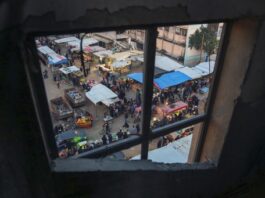JERUSALEM (AP) — The Israeli military confirmed Friday that its forces are operating in central parts of Rafah in its expanding offensive in the southern Gaza city.
Israel launched its ground assault into the city on May 6, triggering an exodus of around 1 million Palestinians out of the city and throwing U.N. humanitarian operations based in the area into turmoil. Still, it has yet to amount to a “major operation” in the eyes of U.S. President Joe Biden’s administration, according to the State Department.
Biden said Friday that Hamas is “no longer capable” of carrying out another large-scale attack on Israel and urged the Israelis and Hamas to come to a deal to release remaining hostages for an extended cease-fire. He said Israeli officials have offered a three-phase deal to Hamas, adding, “Israel has made their proposal. Hamas says it wants a cease-fire. This deal is an opportunity to prove whether they really mean it.”
Cease-fire talks ground to a halt at the beginning of the month after a major push by the U.S. and other mediators to secure a deal, in hopes of averting a full Israeli invasion of Rafah.
Friday’s statement by the Israeli military suggested its forces have been operating in most parts of the city. For its first weeks, the Israeli assault focused on Rafah’s eastern districts and in areas close to the border with Egypt. Israeli troops seized the Rafah crossing into Egypt on the first day of the offensive and have since claimed control over the Philadelphi Corridor, a road running the length of the Gaza-Egypt border on the Gazan side.
Earlier this week, Israeli troops also moved into Rafah’s western district of Tel al-Sultan, where heavy clashes with Hamas fighters have been reported by witnesses.
In its statement Friday, the military said its troops in central Rafah had uncovered Hamas rocket launchers and tunnels and dismantled a weapons storage facility of the group. It did not specify where in central Rafah the operations were taking place, but previous statements and witness reports have pointed to raids in the Shaboura refugee camp and other sites near the city center.
The White House declined to comment Friday on the Israeli operations in central Rafah.
Israel has said an offensive in Rafah is vital to uprooting Hamas fighters in its military’s campaign to destroy the group after its Oct. 7 attack on southern Israel. The military has said it found dozens of tunnels in eastern Rafah, including at least 20 along the Philadelphi Corridor.
Up to around 300,000 people are believed to remain in the Rafah area, with an unknown number still in the city itself. Most have flocked to rural areas on the Mediterranean coastline west of the city, said Shaina Low, a spokesperson for the Norwegian Refugee Council, a humanitarian group that operates in the area. That area has seen deadly Israeli strikes the past week.
Palestinians who fled the city have scattered around southern and central Gaza, most of them living in squalid tent camps.
More than 36,170 Palestinians have been killed in Gaza by Israel’s campaign of bombardment and offensives over the past eight months, according to Gaza’s Health Ministry. Its count does not differentiate between civilians and combatants. Israel has vowed to eliminate Hamas to ensure it cannot repeat its Oct. 7 attack, in which militants stormed into southern Israel, killing around 1,200 people and abducting around 250 others. Around 100 hostages are believed to remain in captivity in Gaza along with the bodies of some 30 others.
——
Associated Press correspondent Aamer Madhani in Washington contributed to this report.
This website uses cookies so that we can provide you with the best user experience possible. Cookie information is stored in your browser and performs functions such as recognising you when you return to our website and helping our team to understand which sections of the website you find most interesting and useful.
